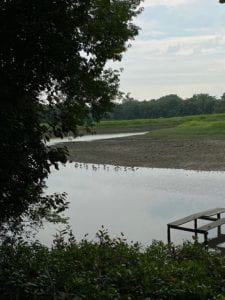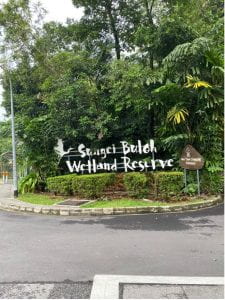I arrived at Sungei Buloh Wetland Reserve (SBWR) on a stormy Saturday afternoon with my project team from the NUS GE3255 Applied, Riparian and Coastal Systems course, clothes damp from the humidity lingering in the air after hours of downpour. Immediately, I was in awe of the dense mangroves that sprawled out towards the sea, perched up on networks of stilt roots over the water (see Figure 1).

Figure 1. The stilt roots of Bakau Minyak (Rhizophoria apiculata) show the unique characteristics of mangrove species. IUCN Red List Status: Least Concern. Local Conservation Status: Native to Singapore (Least Concern (LC))
Photo Credit: Tara Brudar
As I walked on the boardwalk towards the Sungei Buloh Besar River, the song of cicadas pierced through thickets of mangrove holly giving way to Api Api trees and pneumatophores eyeing the ground. Exiting the forest, I crossed the bridge over the river, spotting flocks of birds pecking on a tidal pond. Bird specialist Alan Tan handed me a pair of binoculars. As I squinted at the flocks, he identified the common redshank, greenshank, and a collard kingfisher, all within a hundred meters of another (see Figure 2).

Figure 2. View of Migratory Birds in Tidal Pond from Observation Screen 1.1
Photo Credit: Tara Brudar
I was astonished to learn that these were not local birds, but migratory; they had flown down to Singapore from the North via the East Asian-Australasian Flyway, escaping harsh winter. Viewing these migratory birds revealed to me the importance of mangroves not only for local species, but migratory birds as well.
According to the Malayan Nature Society (MNS), there are 126 bird species at SBWR, the majority migratory from Northern Asia. From August to April, SBWR serves as a key “roosting and feeding area for migratory shorebirds.” However, SBWR has not always been protected: in 1938, mangroves were destroyed by land reclamation projects and agriculture, causing “extensive” habitat loss, forcing migratory birds to Malaysia and Indonesia to rest and feed. Evidently, mangrove destruction in SBWR compromises global-scale migratory routes of birds. In 1986, the MNS petitioned the government, proposing a conservation area to protect the migratory birds and “’natural history’” of Singapore. The proposal was successful, and the restoration of mangroves began in the 1990s. In 1993, the SBWR officially opened as a Nature Park, gaining reserve status and its title in 2002 (see Figure 3).

Figure 3. Sungei Buloh Wetland Reserve Sign, located at the entrance to the nature reserve. Sungei Buloh Wetland Reserve is the official title given to the nature reserve in 2002.
Photo Credit: Tara Brudar
The history of SBWR taught me that global-scale impacts on bird migration occur from mangrove destruction, highlighting the interconnectedness of Earth’s ecosystems. Future conservation efforts should internationally educate the public about how mangrove ecosystems support local and global biodiversity, meriting the concern of all humanity.

Leave a Reply